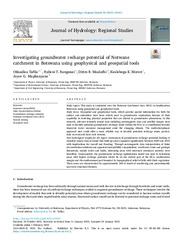Investigating groundwater recharge potential of Notwane catchment in Botswana using geophysical and geospatial tools.
Date
2022-04Author
Tafila, Otlaadisa
Ranganai, Rubeni T.
Moalafhi, Ditiro B.
Moreri, Kealeboga K.
Maphanyane, Joyce G.
Metadata
Show full item recordAbstract
Study region
This study is conducted over the Notwane Catchment Area (NCA) in South eastern Botswana using geospatial and geophysical tools.
Study focus
Geospatial and geophysical tools, which provide spatial information for both the surface and subsurface have been widely used in groundwater exploration because of their capability in detecting physical properties that are related to groundwater phenomena. In this research, relevant remotely sensed data including aeromagnetic data and satellite images were used to identify potential groundwater recharge zones within the NCA as a contribution towards improved water resources management amid the changing climate. The multi-disciplinary approach used could offer a more reliable way to identify potential recharge zones, particularly in semi-arid hard rock terrains.
New hydrological insights for the region
Assessment of groundwater recharge potential looking at remotely sensed data revealed that built-up areas expanded significantly between 2009 and 2019 with implications for run-off and flooding. Through aeromagnetic data interpretation of Euler deconvolution solutions and apparent susceptibility computations, weathered zones and geologic lineaments, mainly dykes and faults, indicating areas with increased secondary porosity were identified. Consequently, the groundwater recharge optimization model was used to determine areas with higher recharge potential which lie on the central part of the NCA, northeastern margin and the southernmost part bounded by topographical relief of hills with thick vegetation. These areas are characterized by approximately 200 m depth of weathering and predominantly east-west structural features.
Collections
- Research articles [88]

